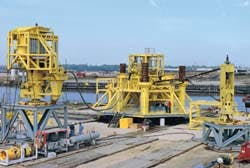Shell Offshore Inc. and partners are set to install a novel subsea gas production system on a four tract unit in 2,000 ft of water in the Gulf of Mexico.
In addition, Shell said, the project will chalk up a series of other technological achievements because either:
- Subsea technology to be applied at Popeye required equipment that didn't exist.
- Viability of future subsea development in deep water demanded lower cost solutions.
In Popeye's $105 million Phase I, gas is to begin flowing by September from the first of two subsea wells. With two wells on line, Popeye's production is expected to reach system capacity of about 120 MMcfd.
Partners plan to transport the production from Popeye unit's six well subsea manifold 24 miles through a 6 in. subsea pipeline to a host platform, Cougar, in about 350 ft of water on South Timbalier Block 300. The 24 mile tieback to Cougar will be the longest in the gulf.
First phase cumulative recovery is expected to amount to 200 bcf of gas and 1.1 million bbl of condensate. With as many as four more wells drilled in a later development phase, recovery could reach 320 bcf and 3 million bbl.
Meantime, Shell let a 3 year contract to a unit of Helmerich & Payne Inc. (H&P), Tulsa, for platform drilling services on its Mars tension leg platform (TLP), set for installation in 1996 in 2,933 ft of water on Mississippi Canyon Block 807. Shell also agreed in a letter of intent to use a second H&P rig on its Ram-Powell TLP to be installed in 3,200 ft of water in spring 1997 on Viosca Knoll Block 956.
TECHNOLOGICAL OVERVIEW
Shell has a number of other deepwater subsea projects planned or under way in the Gulf of Mexico. But the combination of high reservoir pressures, deep water, and other challenging factors at Popeye required Shell and its partners and contractors to enhance existing technology, as well as define new solutions. Systems were developed that make maximum use of rig deployable packages, guidelineless operations, and concurrent installation procedures.
As a result, Shell said, Popeye is to have the first 10,000 psi subsea system based on a guidelineless, diverless, cluster manifold concept, including the gulf's first guidelineless, 10,000 psi subsea trees. Other technological firsts claimed by Shell at Popeye include:
- A guidelineless manifold with a pigging loop that can be recovered through a rig moonpool.
- A jumper system that includes well and flow line steel jumpers, Shell's patented stab and hingeover end termination technology, and diverless, guidelineless, horizontal connections.
- Distributed system controls with separate termination points for electrical and hydraulic umbilicals, readily retrievable components, remotely operated vehicle (ROV) installed umbilical jumpers, and ROV connections of hard pipe termination plates.
Popeye's seven line hydraulic umbilical is the longest installed subsea, has the highest pressure, is bundled in superduplex steel, and allows stab and hingeover installation and termination.
Technological advances at Popeye include guidelineless chokes and control modules that are recoverable with small vessel and ROY assistance, a very long distance signal on power electrical umbilical with standard subsea communications, and a BOP adapter that allows use of a guided drilling system on a guidelineless completion system.
POPEYE FIELD WORK
Popeye operator Shell Offshore and CNG Producing Co. each own a 37.5% interest in the field. Mobil Exploration & Producing Co. and BP Exploration Inc. each hold a 12.5% interest.
In addition to Block 116, the Popeye unit covers Green Canyon Blocks 72, 73, and 117.
Shell acquired Blocks 73, 116, and 117 in 1983 at Minerals Management Service OCS Sale 72 for the Central Gulf of Mexico. Mobil and BP acquired Block 72 at the same sale. Total bonuses for the four tracts amounted to $66 million.
Popeye's estimated $105 million development cost excludes lease bonuses.
Nine exploratory wells have been drilled on the tracts, including Shell's discovery well drilled in 1984-85 on Block 116 by Sonat's Discoverer Seven Seas drillship.
Field reserves are held in two lower Pleistocene turbidite G sand reservoirs. Popeye's subsea production system components are to be clustered around the manifold at a location on the sea floor between the two zones. Phase I wells on Block 116 are drilled to bottom hole locations under Blocks 116 and 73.
Following installation beginning this month of Popeye's 105 ton template and 45 ton production manifold, flow line jumpers are to be installed in May and trees and well jumpers this summer.
TLP PIGS
To meet contractual drilling service obligations on the Mars TLP, H&P unit Helmerich & Payne International Drilling Co. is fabricating a platform drilling unit, Rig 201. H&P early this month was wrapping up Rig 201's design, and construction of the unit was to begin later this month, with delivery scheduled for late 1995.
Pending a definitive drilling services contract, H&P also plans to construct a platform rig for Ram-Powell TLP That unit, Rig 203, is to be built on a schedule that will allow delivery late in 1996.
Upon completion of Rigs 201 and 203, H&P will have 10 platform rigs operating in the Gulf of Mexico and three off California.
Copyright 1995 Oil & Gas Journal. All Rights Reserved.



